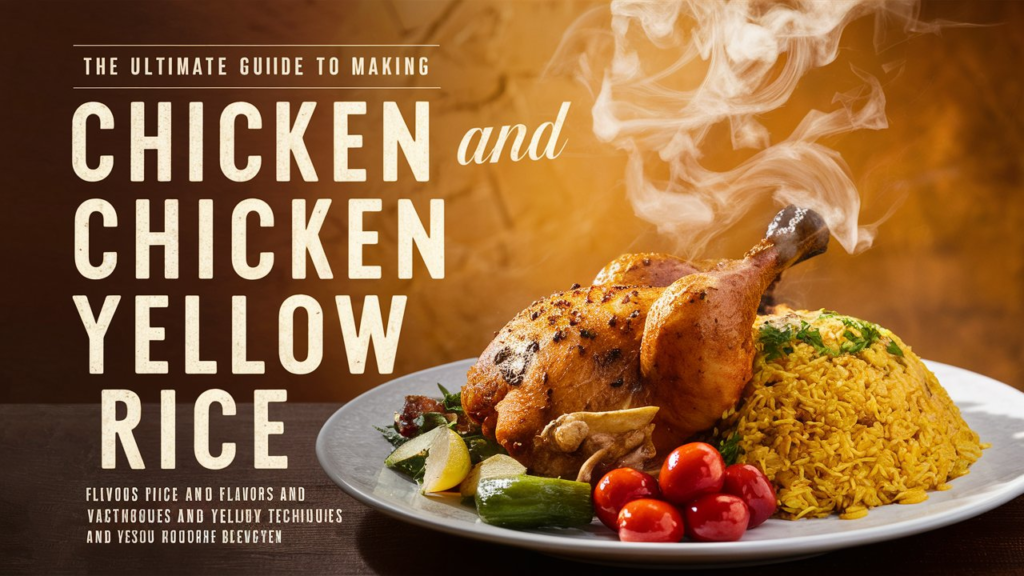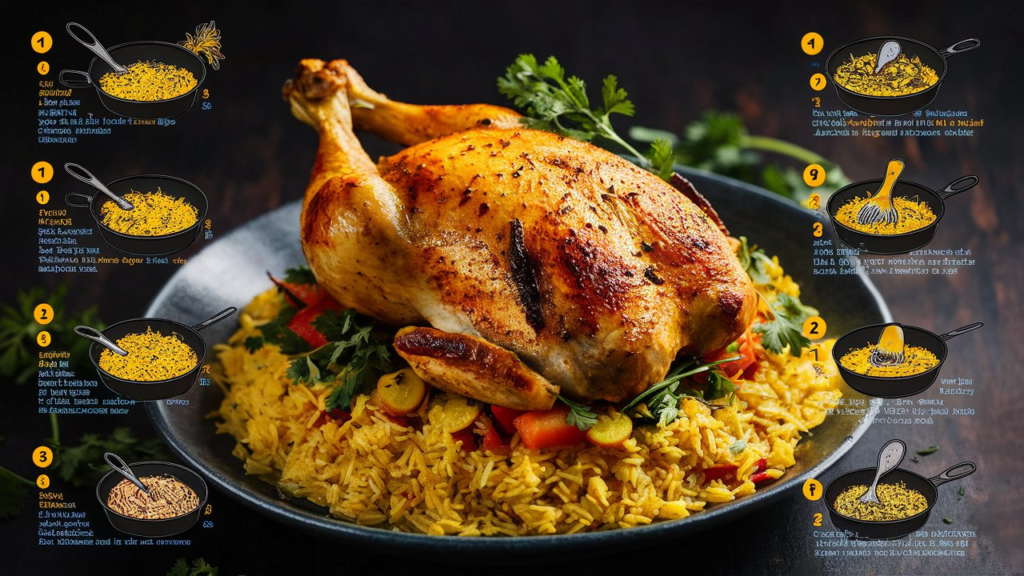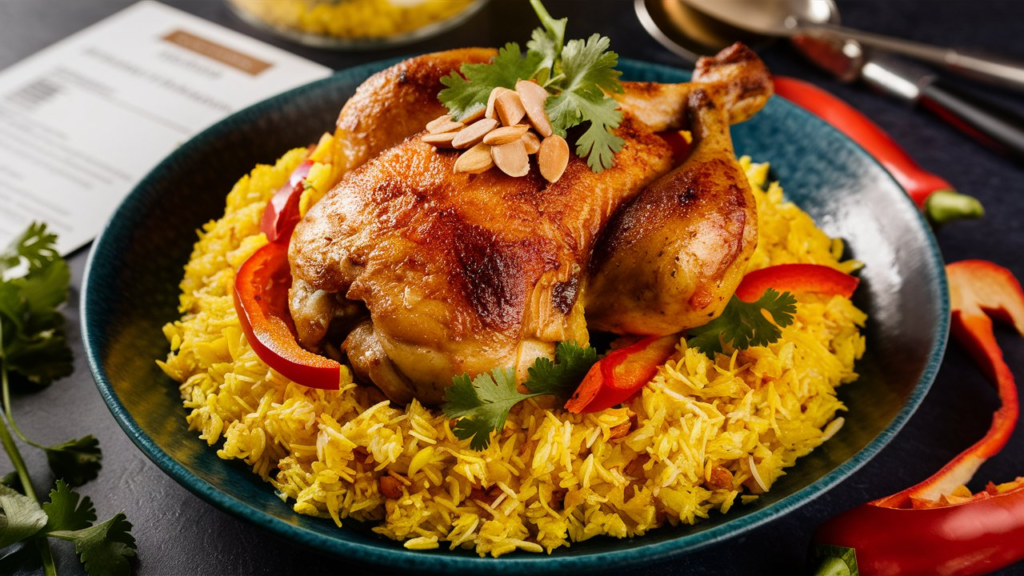Chicken and yellow rice Recipe is a vibrant, flavorful dish that not only fills the belly but also pleases the senses. This one-pot wonder has its origins in various cuisines around the globe, each adding a unique twist to this hearty meal. In this guide, we will walk you through the steps to create an unforgettable chicken and yellow rice meal, packed with tips, tricks, and nutritional insights.
Ingredients and Preparation
Before diving into the cooking process, understanding the ingredients and their preparation is crucial for a successful dish.
Choosing the Right Ingredients
The quality of ingredients directly influences the taste and nutritional value of your meal. For a classic chicken and yellow rice Recipe, you’ll need:
- Chicken: Opt for bone-in, skin-on pieces for maximum flavor.
- Rice: Long grain rice like Basmati or Jasmine is ideal for achieving fluffy, non-sticky results.
- Saffron: This gives the dish its signature yellow color and rich aroma.
- Broth: Chicken or vegetable broth can be used to enhance the rice’s flavor.
- Vegetables and Herbs: Onions, garlic, peas, and red bell peppers not only add color but also layers of flavor.
Preparation Techniques
Proper preparation can simplify the cooking process. Here’s how to get your ingredients ready:
- Marinate the chicken with a blend of spices to enhance its flavor.
- Chop vegetables uniformly to ensure even cooking.
Cooking Tools Needed
For this recipe, ensure you have:
- A large skillet or a Dutch oven.
- A sharp knife for chopping.
- Measuring cups and spoons for accuracy.
Cooking Process
The method you choose to cook your chicken and yellow rice Recipe can vary, but here we focus on the most traditional approach.
Browning the Chicken
Browning the chicken not only enhances its flavor but also locks in juices:
- Heat oil in a pan and sear the chicken pieces until golden brown on all sides.
- Remove the chicken and set aside, leaving the flavorful oils in the pan for cooking the rice.
Sauteing the Vegetables
Building flavor starts with sautéing the right base vegetables:
- In the same pan, add chopped onions and garlic. Cook until they are soft and translucent.
- Add bell peppers and cook for a few more minutes until everything is well combined.
Cooking the Rice and Chicken
Bringing all the components together for the final cook:
- Stir in the rice to coat it in the oils and flavors.
- Add the broth and saffron, then place the chicken pieces back in the pan.
- Cover and simmer until the rice is tender and the chicken is cooked through.
Flavor Enhancements and Variations
Customizing your dish with additional flavors and variations can transform it into something uniquely your own.
Adding Depth of Flavor
Introduce additional elements to deepen the flavors:
- A splash of white wine can add acidity and richness.
- Fresh herbs like cilantro or parsley provide a burst of freshness just before serving.
Dietary Variations
Adapting the recipe to meet dietary restrictions ensures everyone can enjoy this delicious meal:
- For a gluten-free version, ensure all your broth and spices are certified gluten-free.
- A vegetarian version can be made by substituting chicken with chickpeas or another hearty vegetable like cauliflower.
Cultural Twists
Incorporate elements from different cuisines to give your dish an international flair:
- A Spanish version might include chorizo and olives.
- An Indian-inspired version could feature curry spices and raisins for a touch of sweetness.

Serving and Presentation
The final presentation of your dish can make a big impression. Here’s how to serve your chicken and yellow rice with style.
Plating Techniques
Presentation matters, and a few simple techniques can elevate your dish:
- Serve the rice and chicken on a large platter, garnished with fresh herbs.
- Arrange lemon wedges around the dish for added color and a fresh burst of flavor when squeezed over the rice.
Accompaniments
Choosing the right side dishes can complement the main dish:
- A light, crisp salad balances the richness of the rice and chicken.
- A creamy yogurt sauce can add a cooling element to the plate.
Beverage Pairings
Pair your meal with a beverage that enhances its flavors:
- A light white wine like a Sauvignon Blanc pairs well with the herbs and spices.
- For a non-alcoholic option, a mint lemonade can refresh the palate.
In this detailed guide, we’ve explored the art of making chicken and yellow rice, from selecting ingredients to presenting the dish beautifully. This meal not only provides a delightful eating experience but also offers a nutritious balance of protein, carbs,
and vegetables. Customize it to your taste, and enjoy a plate full of color and flavor that promises to satisfy any appetite.
Nutritional Benefits
Understanding the health benefits of chicken and yellow rice can help you appreciate this dish beyond its taste.
Protein-Rich Chicken
Chicken is a low-fat source of high-quality protein, which is essential for muscle repair and growth:
- Opt for chicken thighs for higher iron and zinc content.
- Chicken breast can be a leaner option with less fat.
Whole Grain Goodness
Using whole grain rice can enhance the nutritional profile of your meal:
- Whole grains are a good source of fiber, which helps in digestion and sustained energy release.
- They also contain essential minerals like magnesium and selenium.
Antioxidant-Packed Spices
The spices in this dish aren’t just for flavor; they offer significant health benefits:
- Saffron contains antioxidants that can protect against oxidative stress.
- Turmeric, often used as a substitute for saffron, provides anti-inflammatory benefits.
Storage and Reheating Tips
Proper storage and reheating are essential to maintain the dish’s flavor and safety.
Storing Leftovers
Properly storing your chicken and yellow rice can extend its shelf life:
- Cool the leftovers before refrigerating to prevent bacterial growth.
- Store in airtight containers to keep the dish moist and flavorful.
Best Practices for Reheating
Reheating your dish correctly can help preserve its texture and taste:
- Add a little broth or water when reheating to keep the rice from drying out.
- Heat thoroughly until the internal temperature reaches 165°F to ensure food safety.
Freezing for Later Use
Freezing is a great option for extending the life of your meal:
- Freeze in portion-sized containers for easy weekday meals.

Common Mistakes to Avoid
Even the most experienced cooks can make mistakes. Here are some common pitfalls to avoid when making chicken and yellow rice.
Overcooking the Rice
Cooking rice perfectly is crucial for the texture of the dish:
- Monitor the rice closely as it cooks to prevent it from becoming mushy.
- Use the correct ratio of liquid to rice to ensure it cooks evenly.
Underseasoning
Flavor is key in making this dish memorable:
- Taste as you go and adjust the seasoning with salt, pepper, or spices.
- Remember that spices can lose their potency over time, so fresh is best.
Neglecting the Chicken
The chicken should be flavorful and juicy:
- Do not skip the browning step, as it adds depth to the flavor.
- Be sure to cook the chicken to the proper temperature to ensure it’s both safe and tender.
Engaging with Your Dish
Creating a connection with what you cook can enhance the enjoyment of preparing and eating your meal.
Mindful Cooking
Being present while you cook can turn the preparation into a relaxing activity:
- Enjoy the aromas and colors of the ingredients as you prepare them.
- Consider the origins of each ingredient and the cultural significance of the dish.
Family Involvement
Cooking can be a communal activity that strengthens bonds:
- Involve family members in the cooking process, from choosing the ingredients to stirring the pot.
- Use mealtime to share your day’s experiences and enjoy the food together.
Creative Leftovers
Getting creative with leftovers can extend the enjoyment of your meal:
- Transform leftover chicken and rice into a hearty soup or a filling for wraps.
- Mix in additional vegetables and a fresh splash of herbs to rejuvenate the dish.
In wrapping up this comprehensive guide to making chicken and yellow rice, we hope you feel inspired to try this recipe and make it your own. Whether it’s experimenting with different ingredients or incorporating new cooking techniques, each variation adds a personal touch to this classic dish. Enjoy the process and savor every bite of this delightful meal.
Exploring Regional Variations of Chicken and Yellow Rice Recipe
Chicken and yellow rice Recipe is enjoyed in various forms around the world, each bringing its unique twist to this classic dish. By exploring these regional variations, you can add exciting new flavors to your culinary repertoire.
Spanish Paella
A close relative of the traditional chicken and yellow rice Recipe, Spanish Paella is a rich feast of seafood, meat, and saffron rice:
- This dish typically includes ingredients like shrimp, mussels, and chorizo alongside the foundational chicken and yellow rice Recipe.
- It is cooked in a large, shallow pan to achieve the iconic crispy rice bottom known as socarrat, adding a delightful texture to the chicken and yellow rice Recipe base.
Cuban Arroz con Pollo
The Cuban version of chicken and yellow rice, Arroz con Pollo, is simpler yet packed with flavor:
- The recipe often includes beer and annatto oil, which impart unique flavors and a vibrant color to the chicken and yellow rice.
- Here, the chicken is marinated in citrus and spices before cooking, enhancing the zest and enriching the overall flavor of the chicken and yellow rice Recipe.
Middle Eastern Variations
In Middle Eastern cuisines, chicken and yellow rice Recipe is enhanced with spices and nuts to bring luxurious texture and richness:
- Common additions include almonds, raisins, and a mix of warm spices like cinnamon and cardamom, complementing the chicken and yellow rice beautifully.
- Typically served with sauces such as tzatziki or a tahini-based dressing, these additions perfectly complement the spiced chicken and yellow rice.
Incorporating Local Ingredients into Chicken and Yellow Rice Recipe
Using local ingredients in your chicken and yellow rice can not only improve the freshness of your dish but also support sustainable culinary practices.
Seasonal Vegetables
Integrating seasonal vegetables into your chicken and yellow rice Recipe adds freshness and supports local agriculture:
- Spring versions of chicken and yellow rice might feature asparagus and green peas, adding a bright, fresh taste.
- In autumn, adding squash or pumpkin to your chicken and yellow rice Recipe offers a hearty, seasonal twist.
Local Meats and Grains
Experiment with different local meats and grains to discover new textures and flavors in your chicken and yellow rice Recipe:
- Consider replacing chicken with turkey or duck for a richer flavor in your chicken and yellow rice.
- Try using locally grown rice or other grains like barley or quinoa for a unique take on the traditional chicken and yellow rice Recipe.
Foraging for Herbs and Spices
Foraging for herbs and spices can bring a new dimension to your chicken and yellow rice Recipe dishes:
- Freshly picked herbs like wild garlic or basil can elevate the flavor profile of your chicken and yellow rice.
- Incorporating locally sourced honey or homemade vinegars can add a personal touch to your chicken and yellow rice Recipe marinades.

Sustainable Cooking Practices
Emphasizing sustainability in the kitchen can help reduce waste and promote environmental responsibility.
Reducing Food Waste
Utilize every part of your ingredients to minimize waste:
- Turn vegetable scraps and bones from the chicken into a homemade stock.
Energy Efficient Cooking
Adopting energy-efficient cooking methods reduces your energy consumption:
- Use a pressure cooker or slow cooker, which use less energy than traditional cooking methods.
- Cook in bulk where possible to save both energy and time.
Eco-Friendly Utensils
Choosing the right utensils can make a big difference in your environmental impact:
- Invest in durable cookware made from sustainable materials like ceramic or recycled steel.
- Avoid single-use plastics by opting for reusable silicone or bamboo alternatives.
In conclusion, making chicken and yellow rice Recipe is much more than preparing a meal; it’s an opportunity to explore cultures, experiment with new ingredients, and embrace sustainable practices. Each variation of the dish tells a story, reflecting the traditions and tastes of its origin. By understanding and appreciating these diverse culinary landscapes, you can bring a world of flavors into your own kitchen, making each bite a celebration of global cuisine. Enjoy the journey of cooking, and let every meal be an adventure.
You can get more recipes from here:

